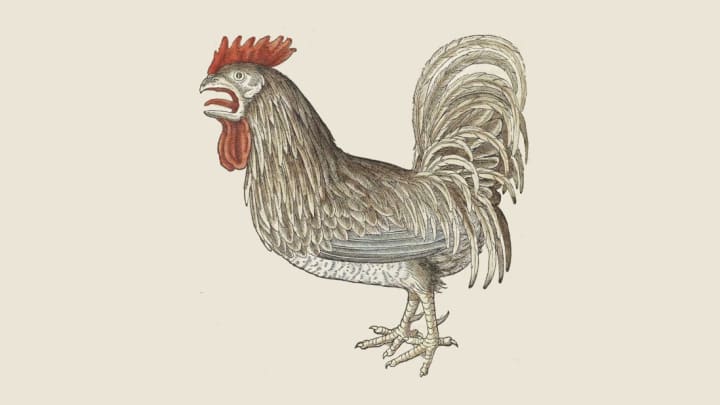Between 1551 and 1558, Swiss doctor and naturalist Conrad Gessner published his magnum opus, the five-volume, 4500-page Historiae animalium, which became the period's most widely read natural history collection. Combining the work of those who came before him, like Aristotle, Pliny, and the unknown author of Physiologus, and making use of both verbal descriptions and illustrations of animals from explorers and other naturalists, Gessner attempted to catalogue all known beasts—even ones we know today to be mythological. "He often assured his readers ... that his friends' testimony was reliable, as they had personally eyeballed even the most ferocious beasts, including lions and crocodiles," writes Michon Scott at Strange Science. "When [Gessner] doubted the accuracy of the opinions he relayed in his own writings, or the validity of the illustrations he included, he prudently said so. Of the multi-headed hydra, for instance, he observed, 'ears, tongues, noses, and faces are inconsistent with the nature of serpents.'"
Historiae animalium was a standout because of the sheer number of its illustrations, which were created using woodcuts; Gessner and the artists he worked with got some animals very close to right, while others are entirely off the mark. “A visual game of telephone is, to some degree, what the artists were dealing with in the 16th century,” Tom Baione, Director of the Department of Library Services at the American Museum of Natural History, told Mental Floss when we first looked at some illustrations from Historiae animalium in 2013. Here are a few more illustrations for you to admire.
1. Beaver

Beavers do have pretty gnarly incisors—they're harder on the front than on the back, which is what creates the sharp edge that allows these semi-aquatic animals to chisel away at wood—but somehow, they don't look as terrifying on the actual animal as they do on this illustration.
2. Porcupine

Every species in the porcupine family—approximately two dozen of them—has a coat of quills to use as a defense mechanism. In real life, though, they don't look quite so sinister.
3. Unicorn

The first written description of a unicorn—which, unfortunately, is not real—appeared in the writings of Greek physician Ctesius, and it doesn't resemble the animal we've come to think of at all:
“There are in India certain wild asses which are as large as horses, and larger. Their bodies are white, their heads dark red, and their eyes dark blue. They have a horn on the forehead which is about a foot and a half in length. The base of this horn, for some two hands'-breadth above the brow, is pure white; the upper part is sharp and of a vivid crimson; and the remainder, or middle portion, is black. Those who drink out of these horns, made into drinking vessels, are not subject, they say, to convulsions or to the holy disease [epilepsy]. Indeed, they are immune even to poisons… “This is the only way to capture them: when they take their young to pasture, you must surround them with many men and horses. They will not desert their offspring and fights with horns, teeth and heels; and they kill many horses and men. They are themselves brought down by arrows and spears. They cannot be caught alive.”
In the fascinating book A Natural History of Unicorns, Chris Lavers examines all the animals that could have possibly been unicorns, and how the creature went from that first description to the beautiful, one-horned horse we think of now.
4. Fox

The drawing is a little more wolf- or coyote-like than an actual red fox, but cute in its own way.
5. Camel

This illustration seems to show a Bactrian camel. These two-humped ungulates are much rarer than their single-humped dromedary cousin—in fact, they're critically endangered [PDF]. This illustration would be more accurate if the beast had more fur and higher humps.
6. Hedgehog

Fact: No illustration could ever be as adorable as the real thing, and this drawing definitely isn't. It makes hedgehogs look shocked and a little curmudgeonly.
7. Elephant

We should all be thankful that elephants aren't this terrifying in real life. Look at that trunk!
8. Armadillo

There are 20 species of armadillo; according to National Geographic, and all of them but one live in Latin America. It's unclear which kind of armadillo this is, but it looks like it just played a wicked joke on one of its brethren.
9. Rooster

One word sums this rooster illustration up, and that word is Ahh!
10. Sea Turtle

In real life, sea turtles don't have teeth; instead, they use their beaks to eat, and stiff, gnarly-looking papillae help direct food to the stomach.
11. Giraffe

If you'd never seen a giraffe before, and someone described it to you, you might draw its ossicones—which are actually cartilage covered in skin—as more typical horns, too. Fun fact: People once called giraffes "camel-leopards" because, thanks to the small hump on the back and the spotted coat, people thought they were a combination of camels and leopards!
12. Crocodile

This croc looks more like a red-eyed crocodile skink—at least around the eyes.
13. Ostrich

The color's not right—those feathers should be darker!—and the beak is a little too thick, but otherwise, this is a pretty good portrait of the world's largest (and heaviest!) bird.
14. Hippopotamus

Hippos are much stouter than this illustration shows, and they prefer to spend most of their time in the water, not walk on it. Hippos and crocs do sometimes face off in the wild, though it probably doesn't go quite like this illustration shows.
15. Whales

Adventures on the high seas must have been terrifying if you thought this was what awaited you. Thankfully, most whales are decidedly less scary than this.
16. Lion

Lion manes are definitely beautiful, but they're not this well-groomed.
